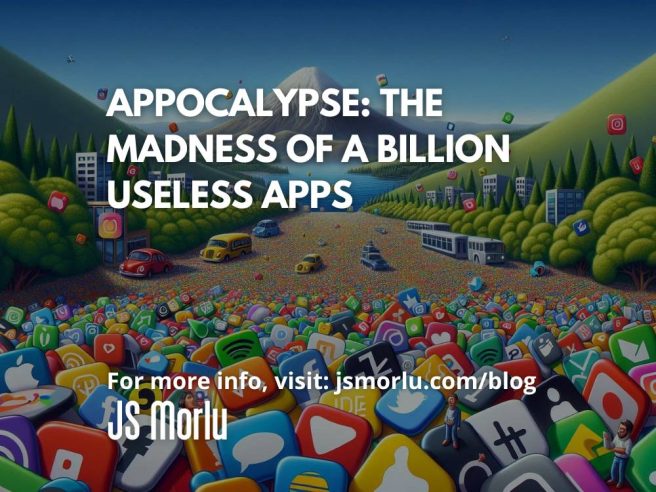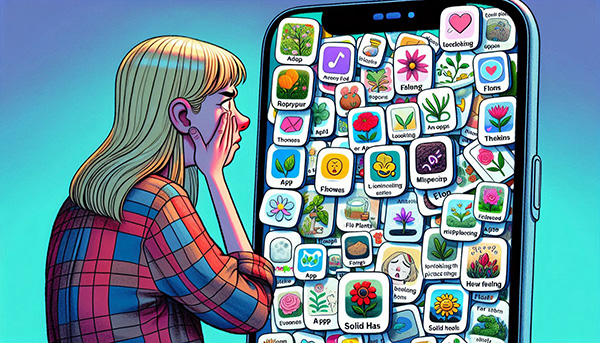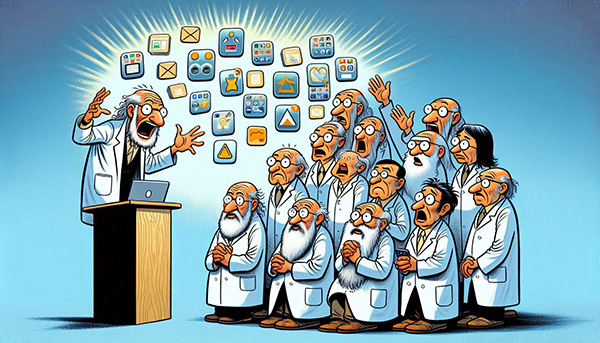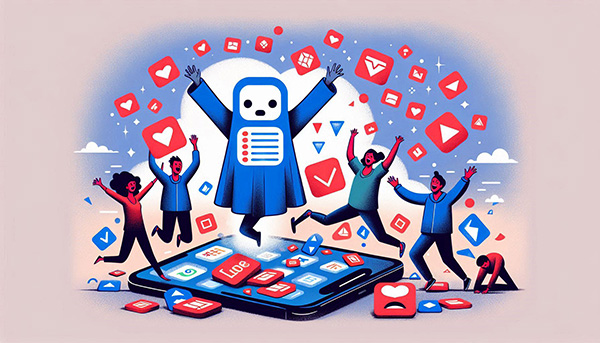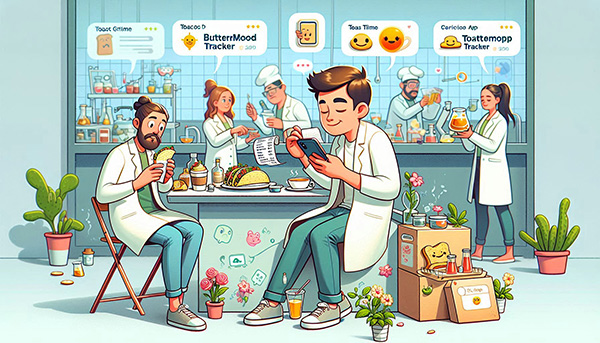By: John S. Morlu II, CPA
Introduction: The Appocalypse Begins
In a world once driven by simple ideas and clever innovations, a strange and overwhelming phenomenon quietly took root in the mystical kingdom of Silicon Vallia. What started as a spark of brilliance—a humble revolution to make life easier—soon morphed into something much more ominous: the rise of a billion apps. No one, not the wisest tech sages, nor the most visionary CEOs, could have predicted what was to come. The dawn of a new era had begun—an era not of enlightenment, but of madness. This was the Appocalypse.
At first glance, the app revolution seemed like the perfect answer to every problem. Why not? These little programs could do practically anything! With a few taps on a screen, you could track every step, organize your life, monitor your health, and yes—if you dug deep enough in the endless app stores—you could even order a life-sized unicorn made entirely of vegan, gluten-free marshmallows (we’re looking at you, Jeff Bezos). Every day promised a new frontier, a fresh leap forward in productivity, convenience, and the sheer joy of customization. Who wouldn’t want to join this digital gold rush?
But somewhere along the way, things went terribly wrong. The world was supposed to become simpler. Instead, it became cluttered. From a few hundred essential apps, we quickly ballooned to over a billion—many of which seemed to exist only to confuse, annoy, and, more often than not, simply waste time. Most small business owners, once enthusiastic about leveraging this technological bounty, found themselves lost in an ever-expanding digital jungle, swiping endlessly through colorful icons that promised nothing short of revolutionizing their businesses. Only, these promised revolutions rarely came.
Amid this chaos, enter Tom—a well-meaning taco stand owner, running his beloved Tom’s Tacos with dreams as big as his burritos. Tom, like countless other small business owners, had fallen into the seductive trap of the app revolution. Each week, a shiny new app caught his eye, each one whispering the promise that this one would be the secret to taking his business to the next level.
It started innocently enough. Tom downloaded TacoTracker, a basic inventory management app that actually helped him keep track of how much salsa he needed to order each week. It seemed harmless, even helpful. But then, as the app stores are known to do, an ad popped up. This time, it was for something called EngagePalooza, an app that claimed to automate customer loyalty with clever taco-related memes, no less. What followed was not just another app download, but the beginning of Tom’s descent into the madness of the Appocalypse.
What happens when we’re promised everything in a sea of over 1 billion apps, only to find ourselves adrift in a digital ocean of clutter, confusion, and absurdity? Tom’s story is a cautionary tale for the modern entrepreneur—a tale of apps gone wild, where the line between innovation and insanity is thinner than a tortilla chip. Welcome to the Appocalypse, where more is less, and sometimes, the only thing a business truly needs is a little less technology and a lot more common sense.
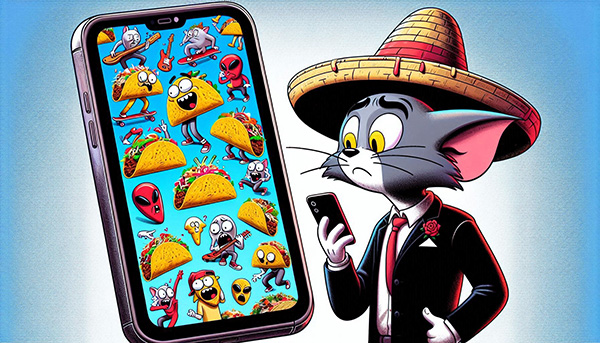
Chapter 1: The Rise of the Useless
In a world where apps promised to solve every problem known to humankind (and some nobody even knew existed), our hero Tom fell victim to the siren song of over-automation. The adventure began with an ad that promised magic:
“Download EngagePalooza,” the ad declared in bold, neon letters. “It will send personalized taco memes to your customers, increasing engagement by 300%!”
Now, Tom had never considered tacos as part of his marketing strategy, but if tacos were the key to a 300% boost in engagement, who was he to question the experts? After all, who doesn’t love tacos? With a grin and a swipe, he eagerly downloaded the app, imagining streams of delighted customers lining up to thank him for the taco-filled joy about to grace their inboxes.
The Taco Meme Tsunami
Within minutes, Tom’s phone became a taco-tropolis of pings, dings, and buzzes. Notifications arrived in an endless barrage, each more baffling than the last: a taco playing the guitar, a taco in sunglasses riding a skateboard, a taco doing… taxes? Tom furrowed his brow. Were these really going to boost customer engagement?
As it turns out, no. No, they were not.
Instead of happy customers showering him with praise, Tom received emails, texts, and even a few disgruntled voicemails. One customer, clearly perplexed, sent a single message:
“Why are you sending me pictures of tacos doing yoga?”
Tom could only shrug as he stared at his screen, wondering if maybe—just maybe—he had made a tiny miscalculation in his quest for marketing glory. But hope dies hard. EngagePalooza promised magic, and Tom believed. For now.
PushOver Pro: The Ultimate Notification…Overlord
With his taco strategy flopping harder than a tortilla on a humid day, Tom sought solace in a new app. Enter PushOver Pro, a miracle tool designed to help users “never miss an important update again!” Tom liked the sound of that. Perhaps PushOver Pro would help organize the chaos that EngagePalooza had unleashed upon his phone.
Little did Tom know, the true genius of PushOver Pro wasn’t in managing notifications—it was in multiplying them. Like a digital hydra, every time Tom cleared a notification, PushOver Pro sent him two more. His phone became a buzzing, pinging, flashing vortex of constant reminders:
“Reminder: Check if HotTaco2024 engaged with your latest meme!”
“HotTaco2024 hasn’t engaged yet. Maybe they hate tacos? You should check!”
His phone had become a 24/7 symphony of sounds, like a concert performed entirely by malfunctioning microwaves. Tom, now haunted by the constant ding of taco memes and reminders, reached the only logical conclusion: more apps.
The Stack of Unnecessary Tortillas
By now, Tom’s app collection had ballooned to 47, each one more specialized (and useless) than the last. He had ChatterBox for customer communication, ZapChat for internal team chats, and AppRanker—an app designed solely to rank his other apps. It was like hiring a life coach to teach your other life coaches how to coach better.
And then there was LettuceNow—an app that tracked lettuce inventory. Tom didn’t sell lettuce, use lettuce, or even eat that much lettuce. But the app had been free for the first 30 days, and who can resist a free trial?
Of course, no one told him that after the trial, LettuceNow would begin sending hourly push notifications to inform him about his lack of lettuce.
“Your lettuce inventory is currently at 0,” it would remind him. “Would you like to order more lettuce?”
It was as if Tom had unwittingly wandered into a strange tech dystopia, where apps were less about solving problems and more about creating them.
A Lesson in Digital Excess
Soon, Tom’s phone was less a tool for running a business and more a digital funhouse of confusion. Notifications, reminders, and pointless updates were stacked as high as his metaphorical taco tower. The irony, of course, was that in his attempt to automate and simplify his life, Tom had made it exponentially more complicated.
It wasn’t long before Tom had a revelation. As his phone buzzed yet again—this time alerting him to a lettuce shortage he didn’t have—he realized that maybe, just maybe, less could be more. Perhaps the true path to success didn’t lie in adding more apps, more systems, and more complexity. Maybe, like tacos, the best solutions were simple, straightforward, and didn’t involve a flood of memes or an endless stream of notifications.
With a sigh, Tom began the arduous task of uninstalling 46 of his apps, starting with EngagePalooza and its relentless taco memes. He kept LettuceNow though—after all, you never know when you might need to track some lettuce.
As Tom reclaimed control of his digital life, he learned a valuable lesson: in a world of endless apps and automation, sometimes the most useful tool is the “delete” button.
Chapter 2: The Almighty Algorithm
At this point, Tom wasn’t just lost in a sea of apps—he was drowning. His phone had become a digital junk drawer, overflowing with random tools that promised salvation but delivered chaos. But Tom wasn’t alone in this struggle; the entire world had fallen prey to the Algorithm Overlords of Google and Apple, the two digital demigods ruling over Silicon Vallia.
The Eternal Truth: More Apps, More Coins
In their infinite wisdom, these tech giants had discovered a universal truth: the more apps people downloaded, no matter how trivial or absurd, the more money flowed into their golden coffers. Somewhere in the shiny halls of Cupertino, Tim Cook raised a glass to Sundar Pichai. Every time someone, somewhere, clicked “Download,” a tiny chime rang out in their secret treasure rooms, where digital coins piled high like some modern-day Scrooge McDuck vault.
Tom’s EngagePalooza mishap? That was just a drop in the ocean of wealth generated by the digital churning of The Algorithm.
For the Overlords, it didn’t matter that CatFact Ultimate was sending out useless trivia about feline digestion every hour or that ButterTimer meticulously tracked the precise moment butter melted at 27 different temperatures. The app stores were temples to the bizarre, and the stranger the app, the higher the praise.
The Algorithm Knows All
Beneath this seemingly random chaos was a secret cult of Silicon Valley sages. These tech mystics, draped in hoodies and sipping ethically sourced cold brew, whispered the gospel of their all-powerful ruler: The Algorithm. Its wisdom was unmatched, its reach unstoppable. Every swipe, every tap, every confused user desperately trying to silence their notifications—each was another offering to the great digital deity.
Somewhere deep within Silicon Vallia, under layers of security, a supercomputer known only as The Processor hummed away. Its sole purpose? To churn out new, gloriously useless apps at an industrial scale. It was responsible for the rise of ToastPredictor (an app that proudly predicted when your toast was about to pop) and PlantWhisperer (which specialized in shouting motivational quotes at your houseplants).
The Processor wasn’t just an engine of code; it was the ultimate creator of chaos. It could analyze millions of users’ behaviors and find the one thing they didn’t know they needed—a digital companion to remind them, say, that their umbrella was looking lonely in the corner. Or that ToastPredictor had predicted “toast-popping” five seconds early today and should be re-calibrated immediately.
App Worship: The Rise of the Pointless
Tom had been unknowingly inducted into this cult. With each app he downloaded, he fed the beast that was The Algorithm. It wasn’t just Tom—no, the world had fallen under its spell. Millions of people became worshippers of the Next Big App. They lined up to download apps like SnoozeMaster, which allowed users to snooze reminders about other reminders, and BeanCount, a coffee bean inventory app that only worked with a very specific brand of beans harvested from a remote farm in Guatemala.
Some people even boasted about how many apps they had. The more, the better! But like a digital hoarder, Tom’s life became cluttered and nonsensical. At this point, Tom had apps for things he didn’t even do—PastaPerfecter, an app that calculated the optimal boiling time for obscure pasta shapes, was one such shining example. Tom hadn’t eaten pasta in months.
The Metrics Gods Smile Upon Confusion
Meanwhile, somewhere in Silicon Vallia, analysts at Google and Apple cackled over engagement metrics, watching in glee as confusion skyrocketed. Users like Tom didn’t know what half their apps did, but they kept downloading more. The app world was like a buffet: sure, you might not need three different potato salads, but hey, they’re there, so why not?
Every click was a victory. Even if Tom never used ZapChat (the app he downloaded for internal communication that he had no team to communicate with), The Algorithm considered it a win. Metrics like Ad Click Rates, Daily Active Users, and Time Spent on Useless Features were the ultimate offerings.
“Keep the users engaged, even if they have no idea why,” was the mantra of the sages. The more confused people were, the more they would look for solutions—solutions that, conveniently, came in the form of even more apps.
Tom’s Realization (Sort Of)
As Tom’s notifications grew wilder, and his apps began overlapping in function (did he need three different lettuce-tracking apps?), a faint realization dawned. Maybe—just maybe—the Algorithm didn’t always have his best interests at heart. Perhaps ToastPredictor wasn’t as essential to his life as he once believed.
And yet, Tom couldn’t quite bring himself to delete it. After all, what if, one day, his toast did pop early, and he was unprepared? The Algorithm whispered sweetly in his ear, reminding him that more was always better.
Besides, PushOver Pro was reminding him that he hadn’t checked his lettuce inventory in the last 15 minutes. Maybe it was time to download LettuceMaster Supreme—just in case the other lettuce apps missed something. The Algorithm knows best, after all.
In the land of app addiction, there is only one rule: The Algorithm always wins. And somewhere, deep beneath Silicon Vallia, The Processor continued to churn, working on its next masterpiece: FootReminder—an app that kindly reminded you that you have feet. Because in the world of The Algorithm, there was always room for more.
Chapter 3: The Confusion of the Masses
In the whimsical land of Appocalypse, small business owners had become unwitting victims of app insanity. Research showed that the average business owner now juggled over 60 apps daily—an impressive feat for anyone with a functioning brain, yet utterly ridiculous when they really only needed about five. The other 55? Just digital clutter, like that mysterious Tupperware container in your kitchen that no longer has a matching lid.
Meet Emily: The Tech-Savvy Florist
Enter Emily, a local florist with big dreams and a smartphone filled with app promises. Armed with optimism and a love for flowers, she downloaded PetalPush, an app that promised to enhance her floral arrangements with “augmented reality flower guides.” Instead of enchanting floral insights, she received endless crashes, her phone becoming a reluctant participant in a one-woman tech horror show.
“Maybe it just needs to warm up,” she thought, launching the app for the tenth time that day, hopeful like a toddler trying to convince a cat to play fetch. Each attempt was met with failure. Undeterred, Emily pressed on, convinced she would become the most tech-savvy florist in town—if only she could wrestle her phone into submission.
The App Avalanche
Before long, Emily’s phone had transformed into a digital jungle of floral-themed apps. There was BudBloom, which only displayed pictures of random flowers that Emily could have easily found in a Google image search. Then came GreenThumb AR, an app that overlaid images of plants in her garden but had a knack for misalignment—resulting in a comical scene of sunflowers sprouting from her driveway and daisies floating above her compost heap.
And let’s not forget SoilSentry, which promised to measure soil moisture by merely placing her phone near the dirt. Spoiler alert: it didn’t work. Instead, it treated her phone like a magic wand, making vague claims about her soil being “happy” or “moody.”
“Great, now my soil has feelings,” Emily sighed, contemplating if she should start a therapy group for her plants.
The Appocalypse: Digital Barnacles
In her quest to simplify, Emily tried to delete the apps that were cluttering her screen. But anyone who has ventured too deeply into the Appocalypse knows that once downloaded, apps cling to your phone like stubborn digital barnacles, refusing to be dislodged. For every app she deleted, three more appeared in her suggested downloads, as if they were breeding in the dark corners of her device.
“Why is my phone recommending LilyLingo, an app that teaches you how to speak to lilies?” she grumbled, eyeing the new notification like it was an uninvited guest at a dinner party. “I don’t want to converse with my flowers; I want to arrange them!”
Emily’s phone soon resembled a chaotic floral arrangement itself—an explosion of icons, notifications, and updates all competing for her precious attention. Notifications popped up like wildflowers in spring, each vying for her to check on the latest one-click floral delivery service or join a seminar on “How to Speak Flower-ish.”
The Flower Shop of Confusion
As her digital garden grew, so did her confusion. Each day, her phone buzzed with reminders and updates, turning her once peaceful floral shop into a bustling chaos of notifications. “PetalPush wants to remind you to update your flower style guide!” It chimed. “SoilSentry says your roses are thirsty!” Another pinged.
Emily was not just a florist anymore; she was a floral operation manager with a side gig in tech support for her smartphone. She fantasized about a world where technology simplified her life rather than complicating it. Surely, there had to be a better way to arrange flowers without wading through a sea of useless apps!
Tidbits of Wisdom
In her quest for clarity, Emily stumbled upon an article titled “Less is More: The Art of Minimalism in App Management.” It turned out there were others like her—business owners trapped in a digital maze, each battling with apps that did little more than clutter their lives.
The article shared nuggets of wisdom, like, “If an app has more notifications than utility, consider letting it go. Your mental space is worth more than a digital hoarder’s paradise!” Emily couldn’t help but chuckle at the absurdity of it all.
The Final Decree: Quality Over Quantity
With newfound resolve, Emily made a pact with herself. She would choose quality over quantity. It was time to prune her app garden, much like she pruned her flowers. One by one, she began deleting the clutter, replacing chaos with simplicity.
Each app she removed felt like shedding a layer of stress, leaving her with just the essentials: a calendar, a budgeting tool, and yes, an app to order flowers—not look at pictures of them.
As she streamlined her digital life, Emily felt lighter. Perhaps she could focus more on what truly mattered—creating stunning arrangements and delighting her customers, rather than deciphering notifications from apps that wouldn’t stop yelling about soil moisture.
A New Dawn for the Florist
With her phone back in check, Emily realized that in the world of small business, less was truly more. And as the digital clutter faded, she could hear the flowers whispering sweet nothings, inviting her to enjoy the beauty of simplicity, just as it was meant to be.
And so, in the midst of the Appocalypse, a single florist found her way back to blooming.
Chapter 4: The Ultimate App
Meanwhile, in the mythical land of Silicon Vallia, where tech wizards conjured apps like wizards cast spells, a clandestine meeting was underway. The sages of the digital realm huddled together, their eyes gleaming with the brilliance of a thousand startup pitches. They had set out on a noble quest: to create the ultimate app, one that would be so delightfully pointless, so utterly devoid of function, it would perfectly encapsulate the swirling madness of the Appocalypse. And thus, they christened it AppApp.
The Concept of AppApp
The purpose of AppApp was gloriously simple: it organized your apps into folders… of more apps. That’s right! For every folder you opened, there were more apps within, each one promising the same level of uselessness. “Why have one app when you can have a dozen more that do absolutely nothing?” proclaimed the lead sage, waving his hands dramatically as if casting a spell over the assembled crowd.
The app had no real function other than to drive engagement—because, as we all know, in the digital kingdom, engagement metrics are king. Users would open AppApp, only to find a delightful labyrinth of additional app suggestions, all vying for their attention, like children at a carnival begging for cotton candy. “Do you like Taco Translator? You might also enjoy Potato Photo Filters!” each notification would chirp.
The Hysteria of Downloads
Tom, Emily, and millions of other bewildered business owners downloaded AppApp faster than a cat meme goes viral. “Finally!” they cried in unison, “An app to manage all my apps!” It was as if someone had invented a magical black hole that absorbed their time and sanity. The irony of downloading an app that did nothing but suggest more apps was blissfully lost on them. They had unknowingly become participants in a digital circus where the main attraction was their own confusion.
As AppApp soared to the number one spot on both Google Play and the App Store, the sages of Silicon Vallia watched with glee. “Our masterpiece!” they cheered, high-fiving over their artisanal avocado toast. They chuckled heartily as they saw their creation spiral into popularity, knowing full well that AppApp was a glorified Pandora’s box of pointlessness.
The AppApp Experience
Once users opened AppApp, they were greeted with a whimsical interface designed to dazzle and disorient. “Welcome to AppApp!” it chirped in an overly enthusiastic voice. “Let’s get you started on your journey to app oblivion! Check out our curated list of totally unnecessary apps just for you!”
The first suggestion was CatFact Ultimate, a classic that sent users hourly trivia about feline behavior. Next up: Boredom Buster, which offered virtual games to help pass the time—because scrolling through your app collection clearly wasn’t enough to keep you busy.
Tom opened AppApp and stared at the suggestions. “A taco translator? Just what I need to order tacos in Spanish!” he said sarcastically, his phone pinging with yet another notification. “Don’t forget ButterTimer! It’ll help you track butter melting rates at different temperatures!”
The Digital Sisyphus
As the days turned into weeks, users found themselves trapped in a digital hamster wheel. They would check AppApp only to be met with more notifications, more suggestions, and even more apps that cluttered their devices. It became a twisted version of Sisyphus’s myth—forever rolling the boulder of app downloads uphill, only for it to roll back down as new, equally useless apps emerged.
Emily found herself cackling at the absurdity of it all as she navigated through folders labeled “Floral Fun” and “Petal Apps.” “Who knew my phone could be a flower shop and a circus at the same time?” she mused, as her fingers danced across the screen, digging through layers of digital nonsense.
Tidbits of Digital Wisdom
In a rare moment of clarity amidst the chaos, a viral meme surfaced online, echoing the sentiments of frustrated users: “I opened AppApp, and now my phone is just a digital Bermuda Triangle!” People shared tales of their app-induced insanity, bonding over the shared experience of being utterly lost in a sea of digital noise.
“Remember,” it advised in a tongue-in-cheek tone, “if you can’t find your productivity, just check your AppApp. It’s definitely hiding somewhere under a mountain of taco memes!”
A Glimpse of Reality
But even in the depths of AppApp-induced madness, a glimmer of reality began to dawn. Users started to realize that perhaps less truly was more. Amidst the notifications, they began to rediscover their original intentions—running businesses, connecting with customers, and enjoying life outside the app-riddled chaos.
As they began to delete the extraneous apps, a new wave of clarity washed over them. “Who needs 60 apps to run a flower shop?” Emily chuckled, deleting three more useless applications as she focused on the beauty of her blooms instead.
The Fall of AppApp
Little did the sages know that their creation, AppApp, was already on a slippery slope. As users wised up, the app’s downloads began to dwindle. “They’re catching on!” one sage exclaimed, panic flashing across his face. “What if they realize we’ve just been leading them to digital madness?”
And so, the saga of AppApp continued, a bittersweet reminder of the fine line between innovation and insanity, a cautionary tale for anyone who dared to venture into the wild world of app downloads. In the end, perhaps the ultimate lesson was that sometimes, the best app is the one you don’t download at all.
Chapter 5: Escape from the Appocalypse
The world had reached peak app madness. Business owners were drowning in subscriptions, notifications, and updates, their phones buzzing like over-caffeinated bees. “I just wanted to run a taco stand,” Tom lamented, staring at his screen, overwhelmed by the relentless tide of digital chaos. It was clear that something had to be done. But how does one escape a world ruled by apps?
The Great Uninstall
Tom, now a wizened figure hunched over his phone, felt a spark of rebellion igniting within him. “Enough is enough!” he declared, channeling his inner taco prophet. He decided to take matters into his own hands. One by one, he began uninstalling every app, watching the icons vanish like bad ideas at a brainstorming session. “Goodbye, CatFact Ultimate! Farewell, MoodToast!” he shouted triumphantly, until only his taco stand app remained.
“No more apps!” he proclaimed, holding his head high like a hero of yore. “I will run my business the old-fashioned way—with a pen, paper, and maybe a good taco meme or two.” And thus, a taco revolution was born.
The Ripple Effect
Tom’s decision sent shockwaves through the realm of Silicon Vallia. Business owners everywhere began to delete their apps in droves, fueled by Tom’s boldness. The streets echoed with the sound of app icons hitting the digital dust. “I used to rely on PetalPush for flower arrangements, but I can just arrange flowers myself!” exclaimed Emily, tossing her phone into her flower bucket for good measure.
Meanwhile, tech CEOs were left reeling. “But we were just about to launch MoodToast,” cried one beleaguered developer, clutching a prototype that could predict your emotional state based on the color of your toast. “It’s revolutionary! People need this!”
The Algorithm in Panic
As more users uninstalled their apps, the mighty algorithm sputtered and coughed, its gears grinding to a halt. The Processor, once a bustling hub of app creation, slowed to a crawl, its lights flickering as if it were contemplating the meaning of its existence. “What do you mean, no more tacos?” it lamented in a digital whimper.
And for the first time in years, people felt free. Freedom felt like stepping into a sunlit meadow after being trapped in a dark cave for too long. It was exhilarating, and the collective sigh of relief resonated throughout the land.
The Rebirth of Simplicity
With the burden of useless apps lifted, business owners rediscovered the joys of simplicity. Tom embraced his newfound freedom and started keeping a handwritten ledger, complete with doodles of tacos and other delicious treats. “This feels… almost nostalgic!” he exclaimed as he documented each sale with flair. He even started a “Taco Tuesday” newsletter using only paper and stamps, which ironically became more popular than any app he’d ever used.
Emily transformed her floral shop into a local community hub, hosting workshops where people could learn about flower arranging without needing an app to guide them. “Let’s embrace the beauty of nature!” she rallied, gathering a crowd of curious locals eager to learn about bouquets, sans any augmented reality overlays.
The Uselessness of Useless Apps
As the app apocalypse dwindled, humorous tales emerged about the useless apps that had once ruled their lives. Memes proliferated, sharing the absurdity of their experiences. “Remember when I downloaded the ButterTimer?” Tom chuckled with friends over tacos. “Who knew my butter needed that much attention?”
A TikTok challenge called #UninstallChallenge went viral, encouraging users to share their most pointless app experiences. Videos flooded in: “Here’s my app for tracking how many times I open the fridge! What was I thinking?” They laughed at their past selves, recognizing the ridiculousness of their app-obsessed ways.
A New Dawn
In the midst of this digital detox, a movement emerged: the “Back to Basics” coalition. Led by Tom and Emily, they advocated for a simpler life, one where connection came from face-to-face conversations rather than notifications. “Why send a taco meme when you can share an actual taco?” Tom mused during one of their meetings, and the crowd erupted in laughter.
The algorithm, realizing it was losing its grip, began to reconsider its approach. “Perhaps we should recommend… less?” it pondered, like a software version of an overzealous personal trainer suddenly realizing that rest days are important too.
A Future Beyond Apps
As the app revolution turned to a retreat, the people of Silicon Vallia began to rebuild their lives, finding joy in the tactile, the real, and the meaningful. Business owners rediscovered their passions and formed genuine connections with their customers—no apps needed.
In the end, Tom stood proudly at his taco stand, a symbol of the movement that had restored balance to their digital lives. “Let this be a lesson to all,” he proclaimed, serving up tacos to a long line of happy customers. “Sometimes the best way to innovate is to simplify. And don’t forget—tacos make everything better!”
And so, with a hearty laugh and a sprinkle of salsa, the residents of Silicon Vallia stepped boldly into a future where joy, connection, and good tacos reigned supreme, forever leaving behind the chaos of the Appocalypse.
Chapter 6: Epilogue: The Future of Apps
In the end, the Appocalypse was not the end of the world but rather a hilarious chapter in the ongoing saga of digital life—a lesson in restraint that would echo through the ages. The people of the land learned to pause and question whether they truly needed an app to measure their daily water intake or if they could perhaps just… drink water when they were thirsty. “What a revolutionary idea!” Tom chuckled, sipping from a glass of water, relishing the simplicity of it all.
The Sages in Their Labs
Meanwhile, the sages of Silicon Vallia retreated into their underground labs, a veritable nerdy cave of wonders. Here, they continued to craft apps for the few who remained enmeshed in the madness. “We must give the people what they want!” one sage declared, donning a lab coat and goggles. “And what they want is the ability to track the exact moment their toast pops!”
Thus, they churned out apps like ToastTime, which not only predicted the toast’s popping time but also provided a soothing soundtrack of elevator music to enhance the experience. Somewhere, a user desperately clung to their phone, convinced that this app was indeed life-changing.
Life Beyond the Appocalypse
For Tom and the other reformed business owners, life outside the Appocalypse was simpler, quieter, and filled with delicious, app-free tacos. Tom found joy in hand-written receipts, reveling in the tactile experience of using a pen. “Look, I can even draw little tacos next to my sales!” he said proudly, as customers chuckled at his doodles.
Emily hosted weekly flower arranging classes in her now-quirky shop, where the only app she used was her timer for brewing the perfect cup of tea. “Who needs AR when you can simply feel the petals?” she would exclaim, showcasing her latest floral masterpieces. “Besides, these blooms won’t judge me if I mess up!”
The App Store Chronicles
As for Google and Apple? They still raked in billions, seemingly unfazed by the app backlash. “You’d be amazed how many people are still willing to download ButterTimer Pro,” whispered a Silicon Vallia insider. “It’s the app that tells you when your butter is at the perfect spreading temperature—because clearly, that’s a crisis waiting to happen!”
It was as if the Appocalypse had become a cautionary tale, a digital fable reminding everyone that sometimes, less really is more. Still, the tech giants churned out marketing campaigns to lure in the nostalgic app users who missed the thrill of the download. “Download now for exclusive features like ‘Butter Mood Tracker’! Find out if your butter is feeling sad!” read the cheeky ad, a tongue-in-cheek jab at the absurdity that once reigned.
A Wiser Yet Foolish World
And so, the world continued, a little wiser, but still a little foolish—always one swipe away from the next big thing in pointless apps. Every now and then, whispers of new creations circulated: CactusCare, which reminded you to talk to your cactus, or SockSorter, an app designed to help you match your socks based on mood. “What’s next?” Tom mused with a grin. “An app that tells you which tacos to eat based on your astrological sign?”
People laughed at the silliness of it all, recognizing that while some innovations were truly beneficial, others were just plain ridiculous. “Let’s keep it real,” Tom said during one of his taco nights with friends. “As long as we have good food and good company, who needs an app to tell us what to do?”
Embracing the Absurd
In this newfound era of moderation, the townsfolk embraced the absurdity of their past with a sense of humor. They shared stories of their app experiences, forming bonds over the common thread of ludicrousness. “Remember when I had an app that tracked how many times I blinked in a day?” Emily laughed, shaking her head. “I ended up with a whole spreadsheet!”
These anecdotes, filled with laughter and a sprinkle of nostalgia, became the fabric of community gatherings. They reminded everyone that technology should enhance life, not complicate it.
The Final Sip of Wisdom
As the sun set over Silicon Vallia, Tom reflected on their journey. “You know,” he said, taking a final sip of his water, “maybe we just need a little balance. After all, while some things are better left to the app store, the best moments in life come from simply enjoying what’s right in front of us.”
And so, with laughter, tacos, and the occasional toast to the absurd, the people of Silicon Vallia found a rhythm—a way to navigate their digital lives with a dash of humor and a big helping of simplicity. They were not just surviving; they were thriving, one app-free taco at a time.
Author: John S. Morlu II, CPA is the CEO and Chief Strategist of JS Morlu, leads a globally recognized public accounting and management consultancy firm. Under his visionary leadership, JS Morlu has become a pioneer in developing cutting-edge technologies across B2B, B2C, P2P, and B2G verticals. The firm’s groundbreaking innovations include AI-powered reconciliation software (ReckSoft.com) and advanced cloud accounting solutions (FinovatePro.com), setting new industry standards for efficiency, accuracy, and technological excellence.
JS Morlu LLC is a top-tier accounting firm based in Woodbridge, Virginia, with a team of highly experienced and qualified CPAs and business advisors. We are dedicated to providing comprehensive accounting, tax, and business advisory services to clients throughout the Washington, D.C. Metro Area and the surrounding regions. With over a decade of experience, we have cultivated a deep understanding of our clients’ needs and aspirations. We recognize that our clients seek more than just value-added accounting services; they seek a trusted partner who can guide them towards achieving their business goals and personal financial well-being.
Talk to us || What our clients says about us

